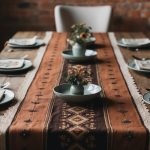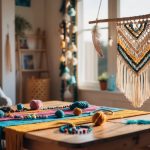Timeless Rugs That Bring Elegance to Any Room: A Classic Style Guide
Dining Area Rugs: Blending Functionality and Style
Choosing a rug for the dining area involves balancing functionality and style. Spills are inevitable, so a rug that conceals stains and is easy to clean is paramount. Textured or patterned rugs can make minor stains less noticeable, maintaining their aesthetic appeal over time.
The rug should extend at least 24 inches beyond the dining table on all sides. This measurement ensures that chairs remain on the rug even when pulled out, preserving a seamless appearance. A low-pile rug facilitates easy movement of chairs.
When it comes to color and design, a rug can bring unity to the dining space, drawing attention to the table as the centerpiece. Opt for a design that complements the tableware and room decor, creating a harmonious dining atmosphere.
The Tranquility of Bedroom Rugs
Bedroom rugs contribute to the room’s tranquility, serving as a soft landing for bare feet each morning. Plush, high-pile rugs enhance comfort, providing a cozy texture underfoot. These rugs can occupy a significant portion of the floor, extending beyond the bed to produce a welcoming feel.
Placement is key; the rug may lie under the bed and extend past it, framing the sleeping area elegantly. Alternatively, smaller rugs might be used on each side of the bed, offering individual comfort.
Color selection affects mood, with soft hues promoting calmness and relaxation. The rug can either blend with existing colors for a serene look or introduce a subtle contrast that adds interest without overpowering the space’s peaceful vibe.
The Practicality of Rug Maintenance
Maintaining the beauty and functionality of rugs involves understanding their durability and the care they require, especially in high-traffic areas. Proper maintenance ensures that rugs retain their elegance while extending their lifespan.
Caring for High-Traffic Area Rugs
Rugs placed in high-traffic areas face more wear and tear, making durability essential. To preserve the rug’s quality, regular vacuuming is crucial. This prevents dirt and grime from embedding into the fibers, which can lead to deterioration. Heavier rugs with low-pile or flatweave designs are often recommended for these spaces, as they tend to withstand foot traffic more effectively.
It is important to rotate the rug every few months. This ensures that wear is evenly distributed and prevents areas from becoming visibly worn down. Using rug pads can also provide additional cushioning and protect the rug from slipping, which helps maintain its original shape and elegance over time.
Simple Tips for Rug Longevity
Ensuring rugs last longer involves more than just regular cleaning. Handling stains promptly can prevent permanent damage; blotting spills instead of rubbing can stop stains from setting. Using mild cleaning products is advisable to preserve the rug’s fibers and color.
They also remain in good condition by shielding the rug from direct sunlight, which can cause fading. Rearranging furniture periodically can help prevent indentations and equalize pressure across the rug. Choosing materials known for durability, like wool or synthetic blends, plays a key role in promoting longevity and sustaining elegance in any room.
Unique Rug Types and Their Uses
Rugs can transform a space with their texture and style. Jute and sisal rugs add a natural touch, shag rugs provide a plush feel, while outdoor rugs extend style into open-air spaces. Each offers distinct characteristics suited for different environments and aesthetics.
Jute and Sisal Rugs for a Natural Look
Jute and sisal rugs are crafted from natural fibers, making them an eco-friendly choice for home interiors. Jute offers a soft texture, suitable for low-traffic areas like bedrooms or living rooms. The neutral tones from their fibers effortlessly blend into various decor styles.
Sisal rugs, though slightly rougher in texture than jute, offer greater durability. Their sturdy nature makes them excellent for high-traffic areas like hallways and entryways. They resist wear and tear, providing longevity without sacrificing style. Unlike synthetic options, both jute and sisal rugs emphasize sustainability while adding natural elegance to any room.
Shag Rugs for Softness and Texture
Shag rugs are synonymous with luxury and comfort, recognizable for their deep pile that invites touch. Originating in the 1960s, they have made a resurgence in modern interiors, where their thick texture adds warmth and coziness. The plush surface creates a relaxed atmosphere, making them ideal for lounging areas or bedrooms.
Different materials such as wool, polyester, or acrylic are used to craft shag rugs, each offering varying levels of softness and maintenance requirements. Their soft fibers are perfect for family settings or where comfort is a priority. While they do require more care, regular shaking or gentle vacuuming can keep them looking pristine.
Outdoor Rugs: Extending Style Beyond the Interior
Outdoor rugs are designed to withstand the elements, bringing indoor comfort and style to patios, decks, or pool areas. Made from durable, weather-resistant materials like polypropylene, they can resist fading from the sun and damage from moisture. This resilience makes them an excellent choice for enhancing outdoor spaces.
These rugs often feature vibrant patterns and colors, adding a lively touch to outdoor decor. Their versatility extends beyond traditional uses, as they can also be used indoors to protect floors in areas exposed to high moisture, such as mudrooms or kitchens. With proper care, these rugs maintain their aesthetic appeal and functionality across seasons.



